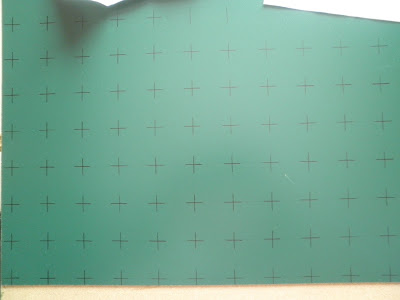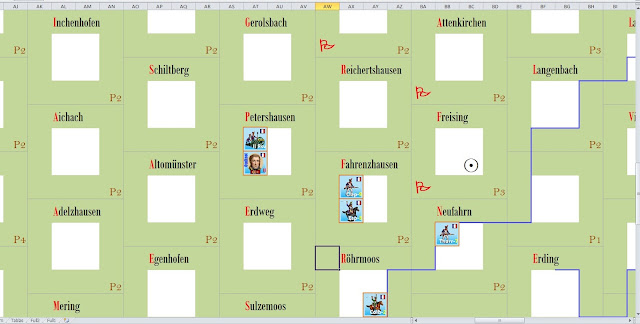I
have uploaded a single MSExcel file which is a development of an idea
of Nic Birt for my Pas de Manoeuvre! system, to set the battlefield
orders of non-player depending on various factors (terrain, balance
between player and NP troops, support by own forces, etc), after a
number of turns or hours. I have included a help file and optionally
cards to use as a reminder of the actions of the non player.
You can modify it freely for your needs. Any comments will be appreciated.
I hope you find it useful.
_________________________________________________________________________
LA IDEA
Hace algún tiempo y buscando ideas para el mecanismo en solitario de Pas de Manoeuvre! me topé con la interesante página de Nic Birt llamada "Franco-Prussian Wargame Campaign 1870" - French
Battlefield Orders (http://www.geocities.ws/fpwargame/Battlefield-Orders.html), cuya secuencia de juego es la siguiente:
Secuencia
1. Colocar el terreno y las figuras francesas y prusianas.
2. Escribir las órdenes prusianas para las tres primeras horas de batalla.
3. Decidir si los franceses están a la defensiva o a la ofensiva según la situación de la campaña.
4. Generar las órdenes francesas para tres horas siguiendo las reglas descritas.
5. Repetir los pasos 2 a 5 cada tres horas de batalla.
Repasando
las reglas son bastante lógicas y al mismo tiempo sencillas en su
concepto, por lo que he intentado agilizar los cálculos a realizar con
una sencilla hoja de MSExcel, y dando de 1 a 5 opciones para posibles
sectores en el campo de batalla.
Pantallas de la aplicación
 |
| Menú principal |
- En primer lugar colocamos las fuerzas del jugador y del No-jugador (a partir de ahora NJ), sin contar las reservas con que cuente aparte el total del cuerpo o ejército,
sólo las que se encuentren en esa sección o área del campo de batalla,
en 1ª y 2ª líneas de combate. Seguidamente, según el punto 3 anterior,
decidir si el NJ está a la ofensiva o a la defensiva (lo podemos
modificar también para cada zona si queremos ser más específicos para
cada momento en concreto) y señalarlo con una "x".
-
Consignamos el terreno en el que se encuentre el jugador y el NJ. Puede
ser Llano o Abierto, Montañoso, Boscoso o Fortificado. Se pueden añadir
más opciones modificando la fórmula que tenéis situada en la celda C103
y siguientes de ésta hoja. De hecho la intención futura es definir con
alguna opción más este campo.
 |
| Tablas utilizadas para el cálculo de las órdenes del NJ - Opción Tables del menú |
-
Las siguientes cuatro filas definen el resto de fuerzas del NJ que se
hallen en el campo de batalla respecto las que se encuentren en ése
sector concreto del NJ, en definitiva el apoyo con el que cuenten o no
en un sector determinado.
-
A continuación, y como opción aparte, podemos definir el nombre y valía
del comandante al mando del sector del NJ. La valía está contabilizada
de 0 a 10, pero como en el caso del terreno, también se puede modificar a
gusto del interesado.
-
Finalmente sólo nos quedará presionar con el botón izquierdo del ratón
sobre el cuadro naranja 1D6 cuando aparezca la mano del puntero y nos
generará un número aleatório de 1 a 6, que acabará de definir la orden
en cuestión para el NJ así como las tropas en 1ª y 2ª línea que
tendremos que situar.
 |
| Hoja de Ayuda - opción Help del menú |
Aparte hay dos hojas más:
-
una sencilla ayuda en inglés para cada cuadro, ya que éste mismo
archivo se subió en la web de SoloWargame Yahoo Groups hace 1 ó 2 días,
pero obviamente se puede cambiar en el idioma que os interese, ya que
son Comentarios de MSExcel cuyo contenido puede cortarse y pegarse
fácilmente;
-
una hoja con cartas (cards) para recordar cada órden los movimientos y
acciones de tropas que comporta. Al igual que en el caso anterior,
pueden modificarse a vuestra conveniencia o para el período en el que
desarrolleis la contienda.
 |
| Cartas - Opción Cards del menú |
Por
último, cualquier comentario u observación razonables que querais
realizar sobre el contenido de la hoja o variaciones que puedan hacerse
en la misma serán bienvenidos.
_______________________________________________________________________________________
Fuente:
Nic Birt's "Franco-Prussian Wargame Campaign 1870" - French Battlefield Orders homepage
(http://www.geocities.ws/fpwargame/Battlefield-Orders.html)













































